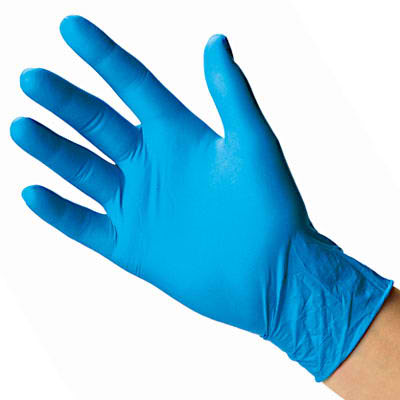Give Us A Hand: Gloves, PPE, and Biohazard Awareness

We often think of gloves as just something we wear to stay warm, or for odd jobs that might be difficult for bare hands. But gloves are much more than that. They are also one of the most important and common components of Personal Protective Equipment (PPE) that one can wear on the job. Some gloves protect our hands from scrapes and scratches while more specialized gloves help protect us dangerous chemicals, contaminants, or even bloodborne pathogens.
Types of Gloves
No single glove can provide appropriate protection for every work situation, so it is important to assess the risk for each task and select a glove that provides the protection you need. The following is a list of gloves and their appropriate application, according to the National Safety Council:
- Cotton and Fabric Gloves: These basic gloves keep hands clean and may offer protection from light scratches. However, they are not useful when handling liquids or sharps. Often, they are used to keep skin oils off of delicate surfaces or to avoid picking up light dirt.
- Coated Fabric Gloves: This type of glove offers protection against some moderate types of chemicals. We see them most commonly with household chemicals, or in laboratories.
- Rubber, Plastic or Synthetic Gloves: These types of gloves are typically used when cleaning or working with oils, solvents and other chemicals.
- Leather Gloves: Sometimes called welding gloves, leather can resist sparks and moderate heat. Cuts and abrasions also can be minimized by wearing leather gloves.
- Aluminized Gloves: These specialized gloves are recommended for welding, furnace and foundry work, as they provide reflective and insulating protection.
- Kevlar Gloves: These have a wide variety of industrial applications. They are cut- and abrasion-resistant and provide protection against both heat and cold.
- Chemical/Liquid-Resistant Gloves: Several types of gloves help protect against specific chemicals and other liquids, such as blood or biohazardous wastes. Many of these gloves are disposable, which is necessary to prevent cross-contamination with various substances. This category of gloves is widely used by everyone from hairdressers to scientists, doctors, and lab technicians. Gloves of this sort include butyl rubber gloves, natural latex/rubber gloves, neoprene gloves and nitrile rubber gloves.
Choosing the Right Glove
The glove selection process starts with an assessment of your risk factors. An overwhelming number of manual jobs involve material and parts handling or operation of heavy equipment where the most common risk is contact with sharp or rough edges. Alternately, if your job involves working with liquid and not sharps, it is more important to pay attention to the water/liquid resistant aspects of the material.
Most challenging are jobs where both liquid resistance and protection from injury are equally important. Aftermath technicians may use several types of gloves during a cleanup to best protect themselves and the customer. Broken glass, wood fragments, and building materials can easily penetrate rubber gloves. However, disposable rubber gloves remain the best option for handling blood and biological wastes.
The importance of grip and fit
Grip and fit are just as important as the material of the gloves you use. It is important to choose the right grip that is compatible with the objects and conditions you are working with so there is no slipping. Choosing the right material and grip combination not only provides better protection, but it may also improve productivity, allowing items to be handled more securely, quickly, and with better dexterity than with bare hands.
Fit is also critical when selecting a glove. Too tight and the glove’s fibers may be too stretched to resist damage from sharp objects. Too loose and the glove may slip, shift, or snag.
Donning and Doffing Gloves
Once you have determined the glove you need, you might assume that putting it on is as easy as gearing up for a winter walk. However, how you put on and remove your PPE can greatly impact its ability to provide protection. Training is required for this step, to ensure that equipment can function as intended.
Depending on how the PPE is used and what industry you are in will determine how best to put on and remove your PPE. Your company’s safety administrator is the best source of information, though OSHA and the CDC also provide online refreshers and instructionals to remind you.
February is Biohazard Awareness Month, and Aftermath is encouraging customers, friends, and associates to understand BBPs and related dangers, and to be aware of how to protect themselves in situations where these risks occur. Furthermore, we believe strongly in the importance of PPE. It’s one of the reasons why we promote BBP awareness to police and other professionals in fields where exposure is possible. If you are a member of law enforcement, request to learn more about our BBP Awareness Presentations and other programs by filling out this online form.
 877-872-4339
877-872-4339  Contact Us
Contact Us 






